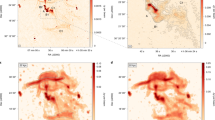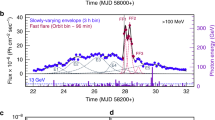Abstract
Several active galaxies emit most of their energy at hv > 100 keV (ref. 1). Observations suggest that their high-energy spectra are strongly variable and are cut off or broken at ∼1 MeV (see for example, refs 2–6 and references therein). A possible explanation of these properties is that the high-energy radiation is produced in the central region (radius R<10Rs, where Rs is the Schwarzshild radius) of the two-temperature plasma accreting onto a supermassive black hole7,8. There, the e+–e− pair creation can be very efficient and, according to our calculations, at a certain luminosity range around Lcr = 0.01 LEdd (where LEdd is the Eddington luminosity) it gives rise to a plasma instability. We show that for a proton temperature close to its virial value, kTpvirial≍ GMmp/R (where mp and M are masses of proton and of the central object respectively), this pair-production instability leads to cyclic variations of the accretion flow, during which high-energy flares are produced. We propose here that the large-amplitude luminosity changes noted in hard X rays and soft γ rays2–6, as well as the soft X-ray outbursts observed in several active galactic nuclei (AGNs)9–11 result from the above mechanism. The same scenario may also be responsible for the short-timescale quasiperiodic variability reported in some proposed galactic black holes12–15.
This is a preview of subscription content, access via your institution
Access options
Subscribe to this journal
Receive 51 print issues and online access
$199.00 per year
only $3.90 per issue
Buy this article
- Purchase on Springer Link
- Instant access to full article PDF
Prices may be subject to local taxes which are calculated during checkout
Similar content being viewed by others
References
Rothschild, R. E. et al. Astrophys. J. 269, 423–437 (1983).
Baity, W. A. et al. Astrophys. J. 279, 555–562 (1984).
Bassani, L. & Dean, A. J. Space Sci. Rev. 35, 367–398 (1983).
Bezler, M. Astr. Astrophys. 136, 351–354 (1984).
Gehrels, N. et al. Astrophys. J. 278, 112–118 (1984).
Ubertini, P., Bazzano, A., La Padula, C. & Polcavo, V. F. Astrophys. J. 284, 54–59 (1984).
Sikora, M. & Zbyszewska, M. Mon. Not. R. astr. Soc. 212, 553–564 (1985).
Takahara, F. & Kusunose, M. Prog. theor. Phys. (submitted).
Marshall, N., Warwick, R. S. & Pounds, K. A. Mon. Not. R. astr. Soc. 194, 987–1002 (1981).
Lawrence, A. Mon. Not. R. astr. Soc. 192, 83–94 (1980).
Lawrence, A., Pye, J. P. & Elvis, M. Mon. Not. R. astr. Soc. 181, 93p–99p (1977).
Samimi, J. et al. Nature 278, 434–436 (1979).
Margon, B., Lampton, M., Bowyers, S. & Cruddace, R. Astrophys. J. Lett. 169, L23–L25 (1971).
Sadeh, D. et al. Nature 278, 436–438 (1979).
Oda, M. Space Sci. Rev. 20, 757–813 (1977).
Svensson, R. Proc. Conf. X-ray and UV Emission from Active Galactic Nuclei, (eds Brinkman, W. & Trumper J.) 152–163 (MPE Rep. 184 1984).
Guilbert, P. W. & Susan Stepney Mon. Not. R. astr. Soc. 212, 523–544 (1985).
Svenson, R. Astrophys. J. 258, 335–348 (1982).
Lightman, A. P., Giacconi, R. & Tananbaum, H. Astrophys. J. 224, 375–380 (1978).
Meszaros, P. & Ostriker, J. P. Astrophys. J. Lett. 273, L59–L63 (1983).
Stellingwerf, R. F. Astrophys. J. 192, 139–144 (1974).
Moskalik, P. Acta astr. (in the press).
Terrel, J. Proc. Conf. X-ray and UV Emission from Active Galactic Nuclei (eds Brinkman, W. & Trumper, J.) 102–104 (MPE Rep. 184 1984).
Allyn Tennant, F. & Mushotzky, R. F. Astrophys. J. 264, 92–104 (1983).
Bassani, L. & Dean, A. J. Astrophys. Space Sci. 100, 457–460 (1984).
Zamorani, G., Giommi, P., Maccacaro, T. & Tananbaum, H. Astrophys. J. 278, 28–36 (1984).
White, N. E., Fabian, A. C. & Mushotzky, R. F. Astr. Astrophys. 133, L9–L11 (1984).
Author information
Authors and Affiliations
Rights and permissions
About this article
Cite this article
Moskalik, P., Sikora, M. Pair production instabilities as a source of X-ray flares from accreting black holes. Nature 319, 649–652 (1986). https://doi.org/10.1038/319649a0
Received:
Accepted:
Issue Date:
DOI: https://doi.org/10.1038/319649a0
This article is cited by
Comments
By submitting a comment you agree to abide by our Terms and Community Guidelines. If you find something abusive or that does not comply with our terms or guidelines please flag it as inappropriate.



